RENAULT ESPACE 2012 J81 / 4.G Owners Manual
Manufacturer: RENAULT, Model Year: 2012, Model line: ESPACE, Model: RENAULT ESPACE 2012 J81 / 4.GPages: 267, PDF Size: 8.95 MB
Page 91 of 267
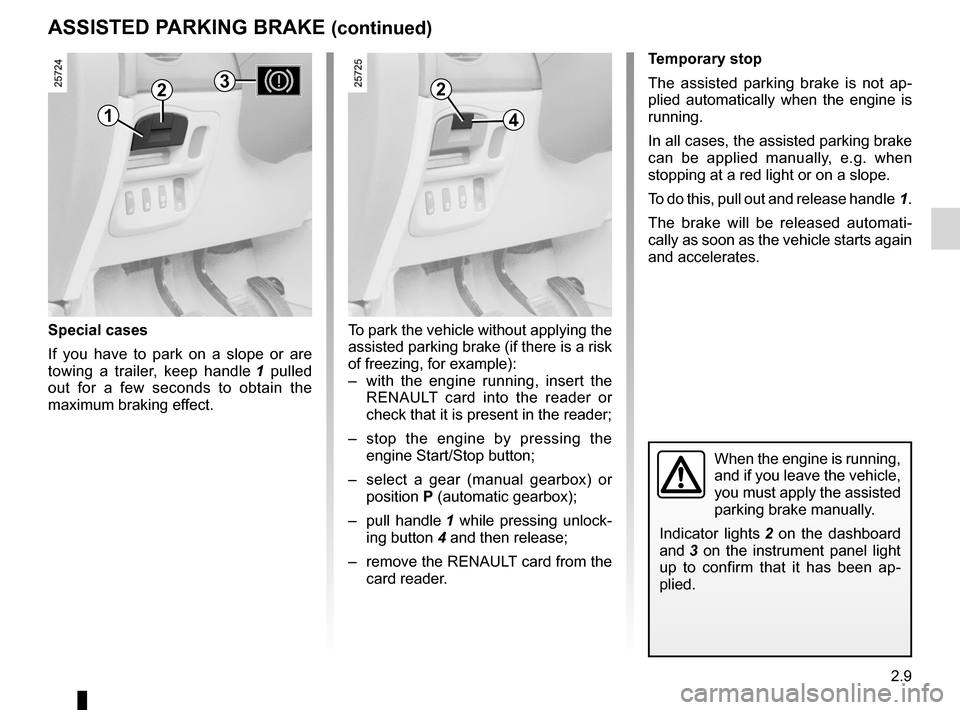
JauneNoirNoir texte
2.9
ENG_UD20366_1
Frein de parking assisté (X81 - J81 - Renault)
ENG_NU_932-3_X81ph3_Renault_2
ASSISTED PARKING BRAKE (continued)
Special cases
If you have to park on a slope or are
towing a trailer, keep handle 1 pulled
out for a few seconds to obtain the
maximum braking effect.
Temporary stop
The assisted parking brake is not ap -
plied automatically when the engine is
running.
In all cases, the assisted parking brake
can be applied manually, e.g. when
stopping at a red light or on a slope.
To do this, pull out and release handle 1.
The brake will be released automati -
cally as soon as the vehicle starts again
and accelerates.
When the engine is running,
and if you leave the vehicle,
you must apply the assisted
parking brake manually.
Indicator lights 2 on the dashboard
and 3 on the instrument panel light
up to confirm that it has been ap -
plied.
To park the vehicle without applying the
assisted parking brake (if there is a risk
of freezing, for example):
– with the engine running, insert the
RENAULT card into the reader or
check that it is present in the reader;
– stop the engine by pressing the
engine Start/Stop button;
– select a gear (manual gearbox) or
position P (automatic gearbox);
– pull handle 1 while pressing unlock-
ing button 4 and then release;
– remove the RENAULT card from the
card reader.
2
41
23
Page 92 of 267
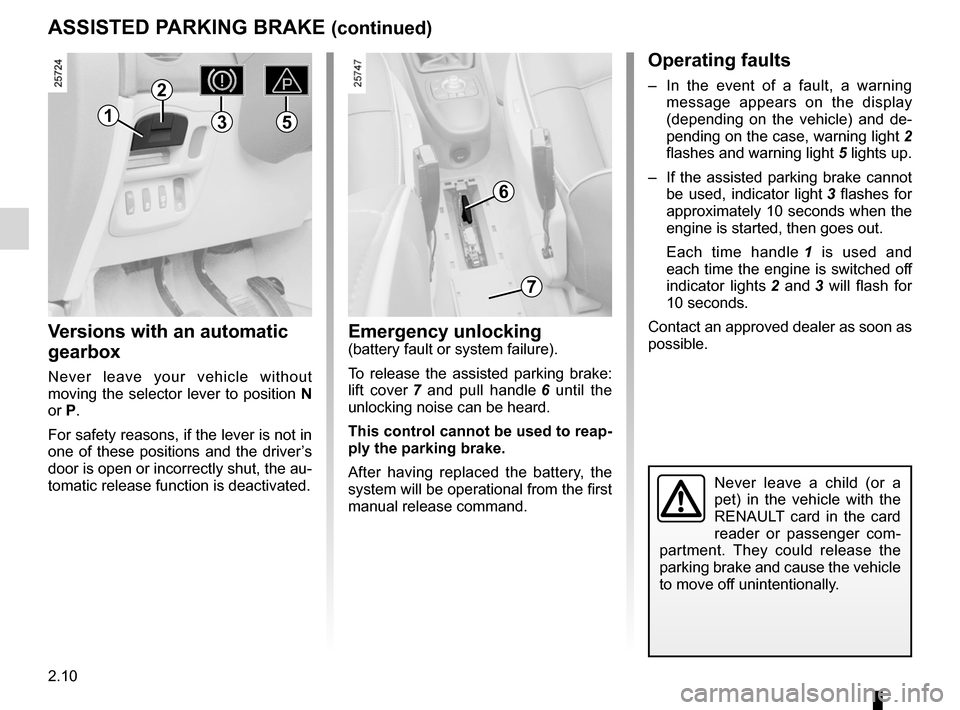
2.10
ENG_UD20366_1
Frein de parking assisté (X81 - J81 - Renault)
ENG_NU_932-3_X81ph3_Renault_2
ASSISTED PARKING BRAKE (continued)
v ersions with an automatic
gearbox
Never leave your vehicle without
moving the selector lever to position N
or P.
For safety reasons, if the lever is not in
one of these positions and the driver’s
door is open or incorrectly shut, the au-
tomatic release function is deactivated.
Emergency unlocking(battery fault or system failure).
To release the assisted parking brake:
lift cover 7 and pull handle 6 until the
unlocking noise can be heard.
This control cannot be used to reap-
ply the parking brake.
After having replaced the battery, the
system will be operational from the first
manual release command.
Operating faults
– In the event of a fault, a warning
message appears on the display
(depending on the vehicle) and de -
pending on the case, warning light 2
flashes and warning light 5 lights up.
– If the assisted parking brake cannot
be used, indicator light 3 flashes for
approximately 10 seconds when the
engine is started, then goes out.
Each time handle 1 is used and
each time the engine is switched off
indicator lights 2 and 3 will flash for
10 seconds.
Contact an approved dealer as soon as
possible.
Never leave a child (or a
pet) in the vehicle with the
RENAULT card in the card
reader or passenger com -
partment. They could release the
parking brake and cause the vehicle
to move off unintentionally.
1
2
6
7
35
Page 93 of 267
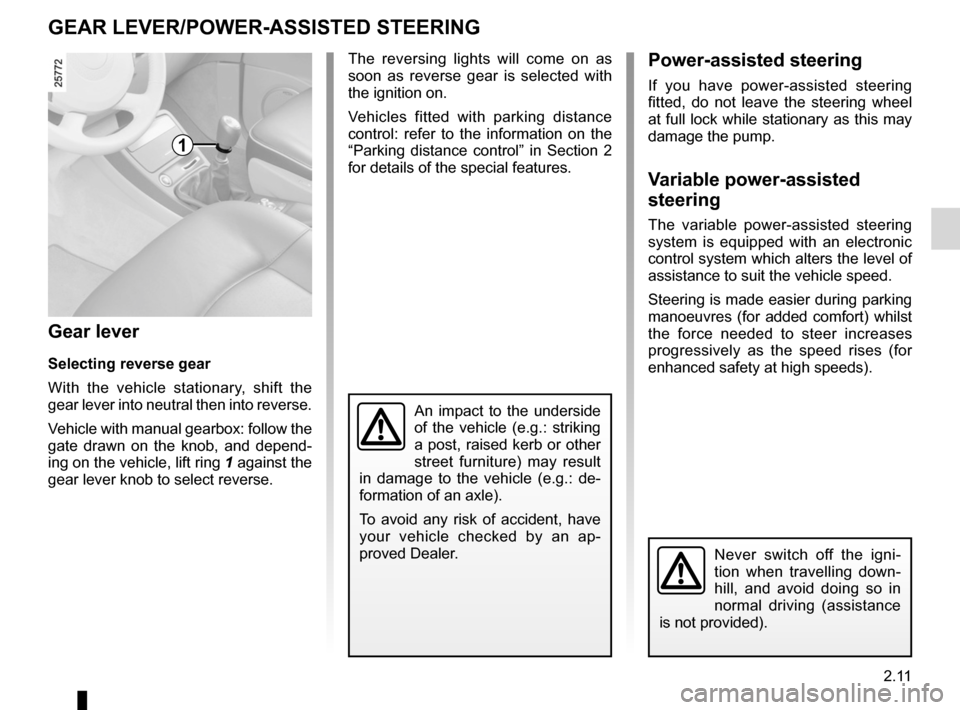
power-assisted steering......................................... (current page)
reverse gear selecting ........................................................... (current page)
power-assisted steering ........................(up to the end of the DU)
driving ................................................... (up to the end of the DU)
gear lever .............................................. (up to the end of the DU)
2.11
ENG_UD15398_2
Levier de vitesses/Direction assistée (X81 - Renault)
ENG_NU_932-3_X81ph3_Renault_2
Gear lever
Power-assisted steering
GEAR LEvER/POWER-ASSISTED STEERING
Gear lever
Selecting reverse gear
With the vehicle stationary, shift the
gear lever into neutral then into reverse.
Vehicle with manual gearbox: follow the
gate drawn on the knob, and depend -
ing on the vehicle, lift ring 1 against the
gear lever knob to select reverse.
The reversing lights will come on as
soon as reverse gear is selected with
the ignition on.
Vehicles fitted with parking distance
control: refer to the information on the
“Parking distance control” in Section 2
for details of the special features.Power-assisted steering
If you have power-assisted steering
fitted, do not leave the steering wheel
at full lock while stationary as this may
damage the pump.
v ariable power-assisted
steering
The variable power-assisted steering
system is equipped with an electronic
control system which alters the level of
assistance to suit the vehicle speed.
Steering is made easier during parking
manoeuvres (for added comfort) whilst
the force needed to steer increases
progressively as the speed rises (for
enhanced safety at high speeds).
Never switch off the igni -
tion when travelling down -
hill, and avoid doing so in
normal driving (assistance
is not provided).
1
An impact to the underside
of the vehicle (e.g.: striking
a post, raised kerb or other
street furniture) may result
in damage to the vehicle (e.g.: de -
formation of an axle).
To avoid any risk of accident, have
your vehicle checked by an ap -
proved Dealer.
Page 94 of 267
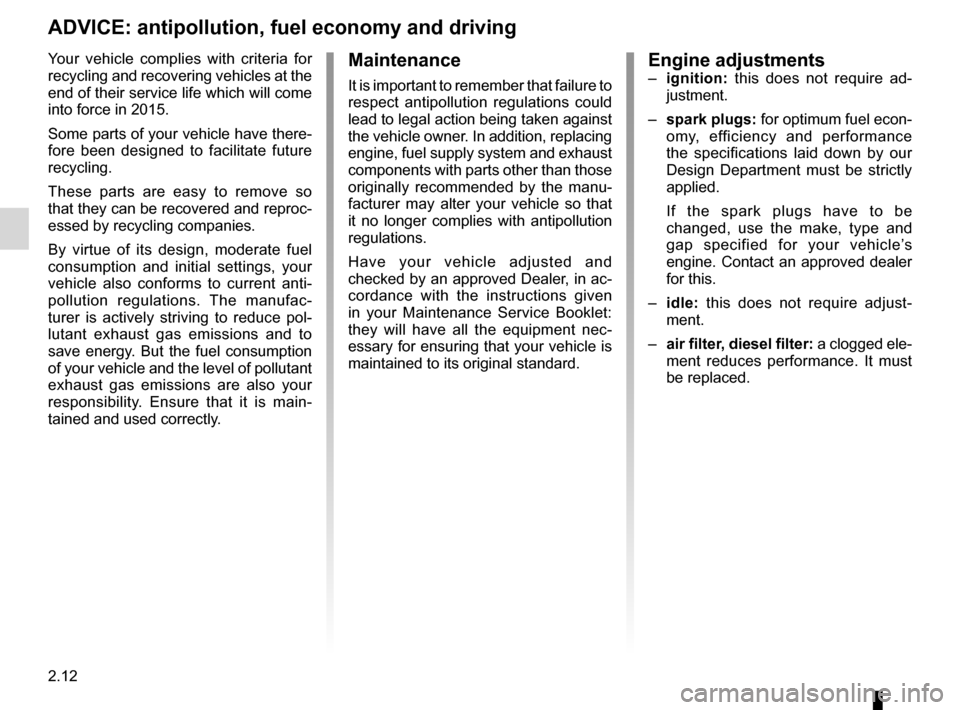
fuel economy ........................................ (up to the end of the DU)
driving ................................................... (up to the end of the DU)
fuel advice on fuel economy .................. (up to the end of the DU)
antipollution advice ............................................. (up to the end of the DU)
advice on antipollution .......................... (up to the end of the DU)
2.12
ENG_UD20368_1
Conseils antipollution, économies de carburant, conduite (X81 - J81 \
- Renault)ENG_NU_932-3_X81ph3_Renault_2
Jaune NoirNoir texte
Advice on antipollution and fuel economy
ADvIcE: antipollution, fuel economy and driving
Maintenance
It is important to remember that failure to
respect antipollution regulations could
lead to legal action being taken against
the vehicle owner. In addition, replacing
engine, fuel supply system and exhaust
components with parts other than those
originally recommended by the manu -
facturer may alter your vehicle so that
it no longer complies with antipollution
regulations.
Have your vehicle adjusted and
checked by an approved Dealer, in ac-
cordance with the instructions given
in your Maintenance Service Booklet:
they will have all the equipment nec -
essary for ensuring that your vehicle is
maintained to its original standard.
Engine adjustments– ignition: this does not require ad -
justment.
– spark plugs: for optimum fuel econ-
omy, efficiency and performance
the specifications laid down by our
Design Department must be strictly
applied.
If the spark plugs have to be
changed, use the make, type and
gap specified for your vehicle’s
engine. Contact an approved dealer
for this.
– idle: this does not require adjust -
ment.
– air filter, diesel filter: a clogged ele-
ment reduces performance. It must
be replaced.
Your vehicle complies with criteria for
recycling and recovering vehicles at the
end of their service life which will come
into force in 2015.
Some parts of your vehicle have there-
fore been designed to facilitate future
recycling.
These parts are easy to remove so
that they can be recovered and reproc-
essed by recycling companies.
By virtue of its design, moderate fuel
consumption and initial settings, your
vehicle also conforms to current anti
-
pollution regulations. The manufac -
turer is actively striving to reduce pol -
lutant exhaust gas emissions and to
save energy. But the fuel consumption
of your vehicle and the level of pollutant
exhaust gas emissions are also your
responsibility. Ensure that it is main -
tained and used correctly.
Page 95 of 267
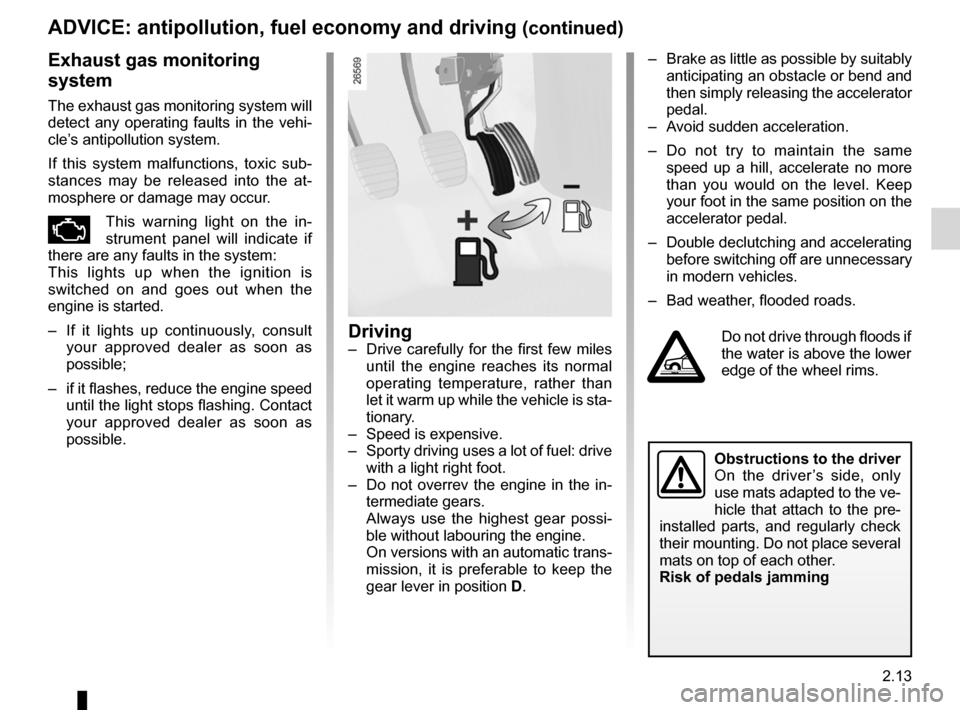
JauneNoirNoir texte
2.13
ENG_UD20368_1
Conseils antipollution, économies de carburant, conduite (X81 - J81 \
- Renault)ENG_NU_932-3_X81ph3_Renault_2
– Brake as little as possible by suitably
anticipating an obstacle or bend and
then simply releasing the accelerator
pedal.
– Avoid sudden acceleration.
– Do not try to maintain the same
speed up a hill, accelerate no more
than you would on the level. Keep
your foot in the same position on the
accelerator pedal.
– Double declutching and accelerating
before switching off are unnecessary
in modern vehicles.
– Bad weather, flooded roads.
ADvIcE: antipollution, fuel economy and driving (continued)
Do not drive through floods if
the water is above the lower
edge of the wheel rims.
Exhaust gas monitoring
system
The exhaust gas monitoring system will
detect any operating faults in the vehi-
cle’s antipollution system.
If this system malfunctions, toxic sub-
stances may be released into the at -
mosphere or damage may occur.
ÄThis warning light on the in -
strument panel will indicate if
there are any faults in the system:
This lights up when the ignition is
switched on and goes out when the
engine is started.
– If it lights up continuously, consult
your approved dealer as soon as
possible;
– if it flashes, reduce the engine speed
until the light stops flashing. Contact
your approved dealer as soon as
possible.
Driving– Drive carefully for the first few miles
until the engine reaches its normal
operating temperature, rather than
let it warm up while the vehicle is sta-
tionary.
– Speed is expensive.
– Sporty driving uses a lot of fuel: drive
with a light right foot.
– Do not overrev the engine in the in-
termediate gears.
Always use the highest gear possi -
ble without labouring the engine.
On versions with an automatic trans-
mission, it is preferable to keep the
gear lever in position D.
Obstructions to the driver
On the driver ’s side, only
use mats adapted to the ve-
hicle that attach to the pre-
installed parts, and regularly check
their mounting. Do not place several
mats on top of each other.
Risk of pedals jamming
Page 96 of 267
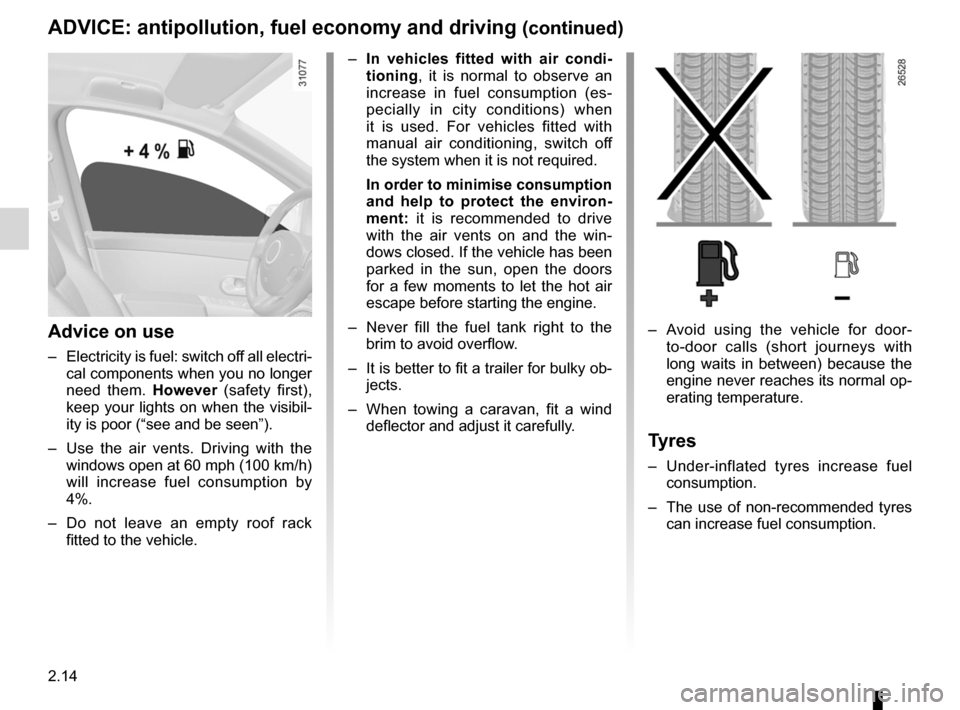
2.14
ENG_UD20368_1
Conseils antipollution, économies de carburant, conduite (X81 - J81 \
- Renault)ENG_NU_932-3_X81ph3_Renault_2
ADvIcE: antipollution, fuel economy and driving (continued)
Advice on use
– Electricity is fuel: switch off all electri-
cal components when you no longer
need them. However (safety first),
keep your lights on when the visibil -
ity is poor (“see and be seen”).
– Use the air vents. Driving with the
windows open at 60 mph (100 km/h)
will increase fuel consumption by
4%.
– Do not leave an empty roof rack
fitted to the vehicle. –
In vehicles fitted with air condi -
tioning , it is normal to observe an
increase in fuel consumption (es -
pecially in city conditions) when
it is used. For vehicles fitted with
manual air conditioning, switch off
the system when it is not required.
In order to minimise consumption
and help to protect the environ -
ment: it is recommended to drive
with the air vents on and the win -
dows closed. If the vehicle has been
parked in the sun, open the doors
for a few moments to let the hot air
escape before starting the engine.
– Never fill the fuel tank right to the
brim to avoid overflow.
– It is better to fit a trailer for bulky ob-
jects.
– When towing a caravan, fit a wind
deflector and adjust it carefully. –
Avoid using the vehicle for door -
to-door calls (short journeys with
long waits in between) because the
engine never reaches its normal op-
erating temperature.
Tyres
– Under-inflated tyres increase fuel
consumption.
– The use of non-recommended tyres
can increase fuel consumption.
Page 97 of 267
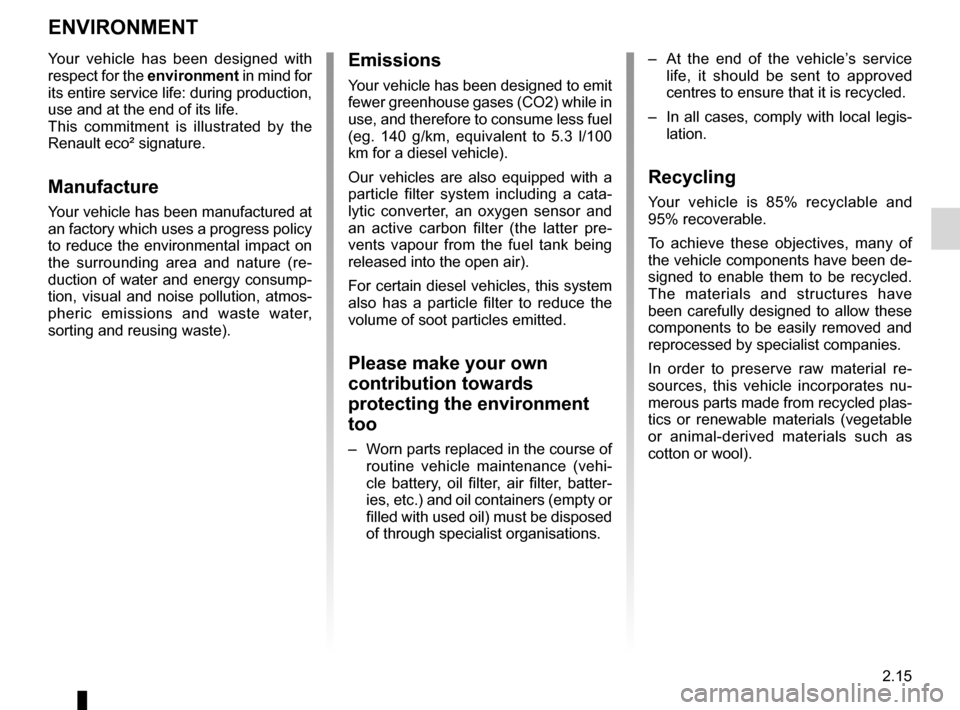
environment .......................................... (up to the end of the DU)
2.15
ENG_UD25716_1
Environnement (sans marque) (X44 - X45 - X77 - X81 - X85 - X90 - X91 \
- X83 - X61 - TEST - X95 - J95 - R95 - F90 Ph2 - X33 - X47 - X43 - X38 - H79 - X62 - X32 -\
X09 -
ENG_NU_932-3_X81ph3_Renault_2
Environment
ENvIRONMENT
Emissions
Your vehicle has been designed to emit
fewer greenhouse gases (CO2) while in
use, and therefore to consume less fuel
(eg. 140 g/km, equivalent to 5.3 l/100
km for a diesel vehicle).
Our vehicles are also equipped with a
particle filter system including a cata -
lytic converter, an oxygen sensor and
an active carbon filter (the latter pre -
vents vapour from the fuel tank being
released into the open air).
For certain diesel vehicles, this system
also has a particle filter to reduce the
volume of soot particles emitted.
Please make your own
contribution towards
protecting the environment
too
– Worn parts replaced in the course of
routine vehicle maintenance (vehi -
cle battery, oil filter, air filter, batter -
ies, etc.) and oil containers (empty or
filled with used oil) must be disposed
of through specialist organisations. –
At the end of the vehicle’s service
life, it should be sent to approved
centres to ensure that it is recycled.
– In all cases, comply with local legis -
lation.
Recycling
Your vehicle is 85% recyclable and
95% recoverable.
To achieve these objectives, many of
the vehicle components have been de-
signed to enable them to be recycled.
The materials and structures have
been carefully designed to allow these
components to be easily removed and
reprocessed by specialist companies.
In order to preserve raw material re -
sources, this vehicle incorporates nu -
merous parts made from recycled plas-
tics or renewable materials (vegetable
or animal-derived materials such as
cotton or wool).
Your vehicle has been designed with
respect for the
environment in mind for
its entire service life: during production,
use and at the end of its life.
This commitment is illustrated by the
Renault eco² signature.Manufacture
Your vehicle has been manufactured at
an factory which uses a progress policy
to reduce the environmental impact on
the surrounding area and nature (re -
duction of water and energy consump-
tion, visual and noise pollution, atmos-
pheric emissions and waste water,
sorting and reusing waste).
Page 98 of 267
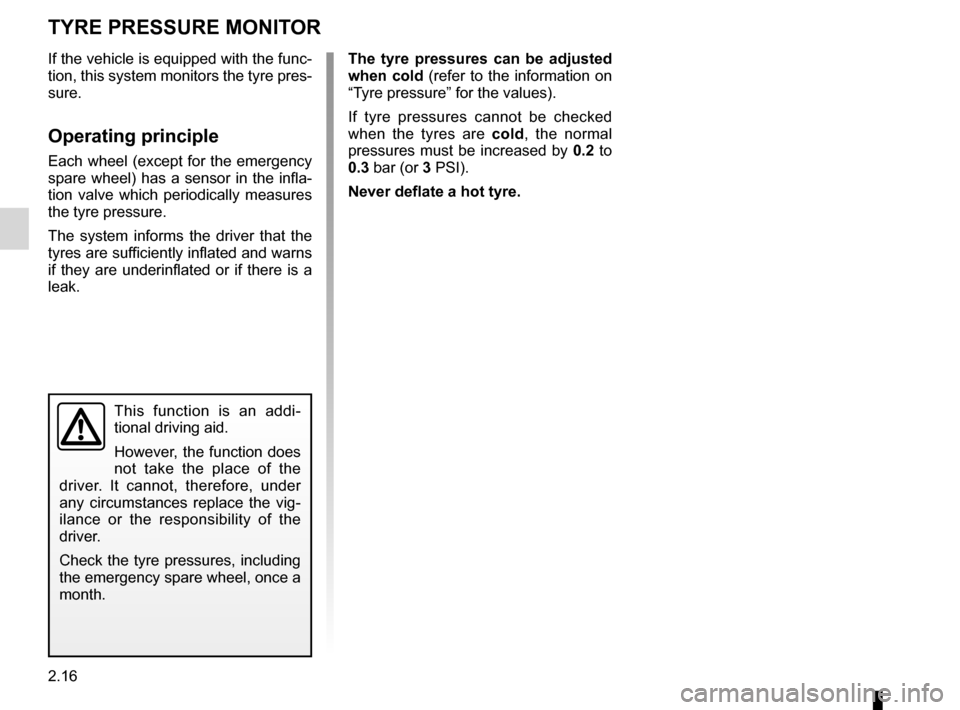
tyres ....................................................................... (current page)
tyre pressure .......................................................... (current page)
tyre pressure monitor ............................................. (current page)
driving ................................................... (up to the end of the DU)
2.16
ENG_UD20370_1
Système de surveillance de pression des pneus (X81 - J81 - Renault)\
ENG_NU_932-3_X81ph3_Renault_2
Jaune NoirNoir texte
Tyre pressure monitor
TYRE PRESSURE MONITOR
If the vehicle is equipped with the func-
tion, this system monitors the tyre pres-
sure.
Operating principle
Each wheel (except for the emergency
spare wheel) has a sensor in the infla-
tion valve which periodically measures
the tyre pressure.
The system informs the driver that the
tyres are sufficiently inflated and warns
if they are underinflated or if there is a
leak.
This function is an addi -
tional driving aid.
However, the function does
not take the place of the
driver. It cannot, therefore, under
any circumstances replace the vig -
ilance or the responsibility of the
driver.
Check the tyre pressures, including
the emergency spare wheel, once a
month.
The tyre pressures can be adjusted
when cold (refer to the information on
“Tyre pressure” for the values).
If tyre pressures cannot be checked
when the tyres are cold, the normal
pressures must be increased by 0.2 to
0.3 bar (or 3 PSI).
Never deflate a hot tyre.
Page 99 of 267
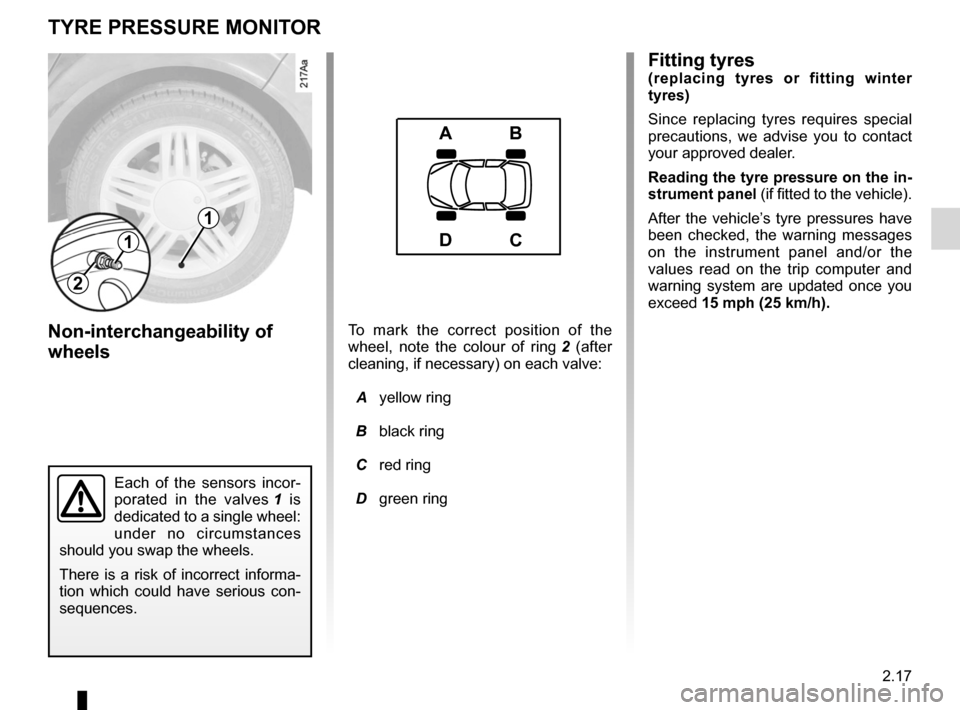
JauneNoirNoir texte
2.17
ENG_UD20370_1
Système de surveillance de pression des pneus (X81 - J81 - Renault)\
ENG_NU_932-3_X81ph3_Renault_2
TYRE PRESSURE MONITOR
Fitting tyres(replacing tyres or fitting winter
tyres)
Since replacing tyres requires special
precautions, we advise you to contact
your approved dealer.
Reading the tyre pressure on the in-
strument panel (if fitted to the vehicle).
After the vehicle’s tyre pressures have
been checked, the warning messages
on the instrument panel and/or the
values read on the trip computer and
warning system are updated once you
exceed 15 mph (25 km/h).
Non-interchangeability of
wheels
Each of the sensors incor -
porated in the valves 1 is
dedicated to a single wheel:
under no circumstances
should you swap the wheels.
There is a risk of incorrect informa-
tion which could have serious con -
sequences.
To mark the correct position of the
wheel, note the colour of ring 2 (after
cleaning, if necessary) on each valve:
A yellow ring
B black ring
C red ring
D green ring
AB
Dc1
2
1
Page 100 of 267
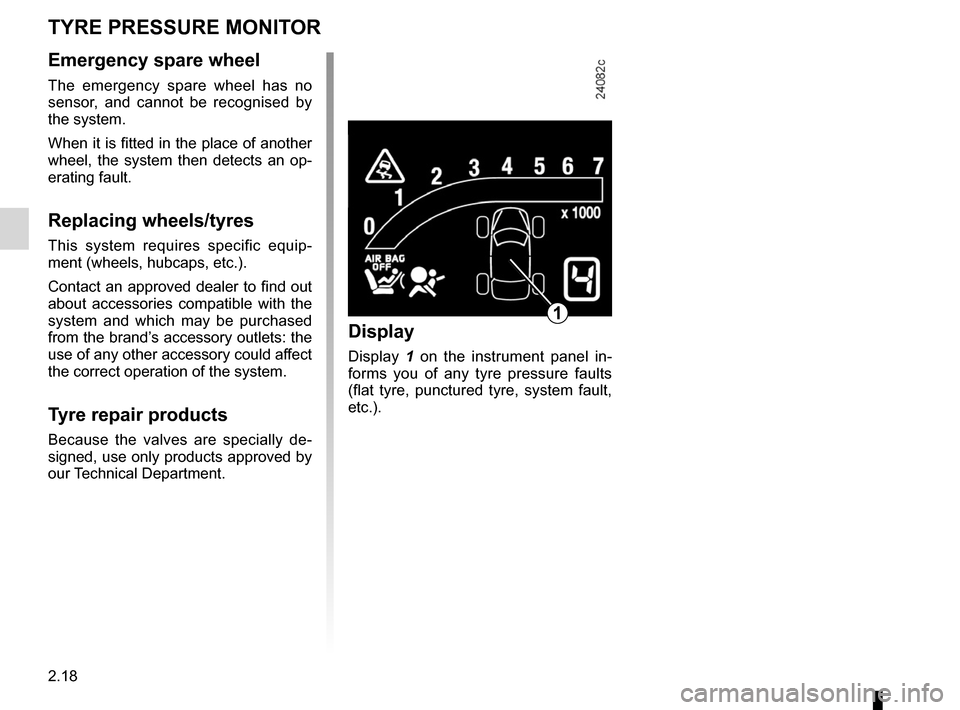
2.18
ENG_UD20370_1
Système de surveillance de pression des pneus (X81 - J81 - Renault)\
ENG_NU_932-3_X81ph3_Renault_2
Jaune NoirNoir texte
TYRE PRESSURE MONITOR
Emergency spare wheel
The emergency spare wheel has no
sensor, and cannot be recognised by
the system.
When it is fitted in the place of another
wheel, the system then detects an op-
erating fault.
Replacing wheels/tyres
This system requires specific equip -
ment (wheels, hubcaps, etc.).
Contact an approved dealer to find out
about accessories compatible with the
system and which may be purchased
from the brand’s accessory outlets: the
use of any other accessory could affect
the correct operation of the system.
Tyre repair products
Because the valves are specially de -
signed, use only products approved by
our Technical Department.
Display
Display 1 on the instrument panel in -
forms you of any tyre pressure faults
(flat tyre, punctured tyre, system fault,
etc.).
1